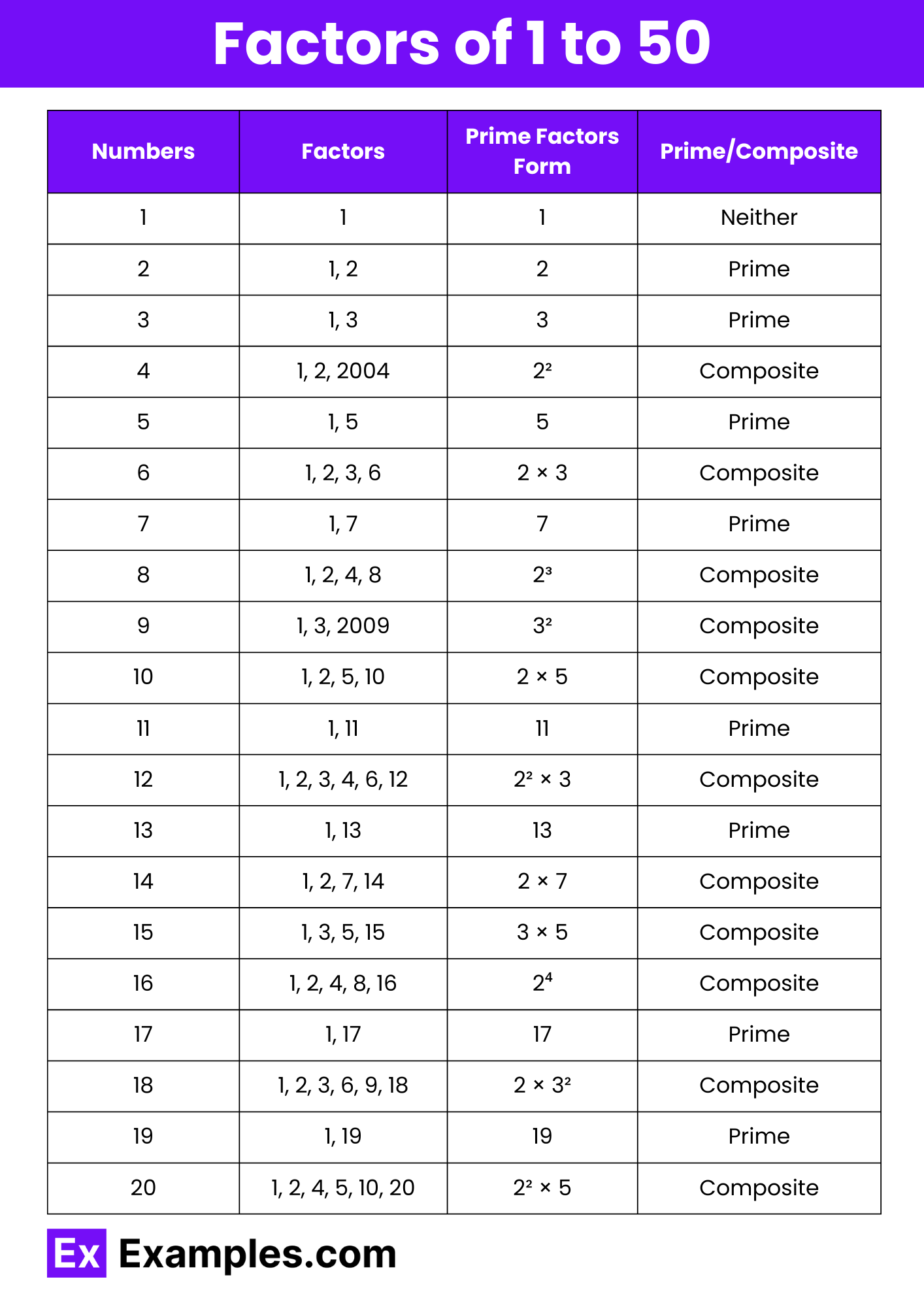What are the factors of 24?
1, 2, 3, 4, 6, 8, 12, 24
1, 2, 4, 6, 12
1, 3, 7, 24
1, 2, 4, 8, 12, 24


Factors are the numbers you multiply together to get another number. For example, the factors of 10 are 1, 2, 5, and 10 because 1 × 10 = 10 and 2 × 5 = 10. Understanding factors is a fundamental concept in mathematics, essential for various applications such as simplifying fractions, finding the greatest common divisors, and solving problems involving multiples and divisibility.
In this guide, we will explore the factors of numbers from 1 to 50. By examining these factors, you will gain a better understanding of how numbers are interconnected and how they can be broken down into their component parts. This knowledge is crucial for advancing in topics such as prime factorization, least common multiples, and algebraic expressions.
Download Factors of 1 to 50 in PDF

Download Factors of 1 to 50 in PDF
| Numbers | Factors | Prime Factors Form | Prime/Composite |
|---|---|---|---|
| 1 | 1 | 1 | Neither |
| 2 | 1, 2 | 2 | Prime |
| 3 | 1, 3 | 3 | Prime |
| 4 | 1, 2, 4 | 2² | Composite |
| 5 | 1, 5 | 5 | Prime |
| 6 | 1, 2, 3, 6 | 2 × 3 | Composite |
| 7 | 1, 7 | 7 | Prime |
| 8 | 1, 2, 4, 8 | 2³ | Composite |
| 9 | 1, 3, 9 | 3² | Composite |
| 10 | 1, 2, 5, 10 | 2 × 5 | Composite |
| 11 | 1, 11 | 11 | Prime |
| 12 | 1, 2, 3, 4, 6, 12 | 2² × 3 | Composite |
| 13 | 1, 13 | 13 | Prime |
| 14 | 1, 2, 7, 14 | 2 × 7 | Composite |
| 15 | 1, 3, 5, 15 | 3 × 5 | Composite |
| 16 | 1, 2, 4, 8, 16 | 2⁴ | Composite |
| 17 | 1, 17 | 17 | Prime |
| 18 | 1, 2, 3, 6, 9, 18 | 2 × 3² | Composite |
| 19 | 1, 19 | 19 | Prime |
| 20 | 1, 2, 4, 5, 10, 20 | 2² × 5 | Composite |
| 21 | 1, 3, 7, 21 | 3 × 7 | Composite |
| 22 | 1, 2, 11, 22 | 2 × 11 | Composite |
| 23 | 1, 23 | 23 | Prime |
| 24 | 1, 2, 3, 4, 6, 8, 12, 24 | 2³ × 3 | Composite |
| 25 | 1, 5, 25 | 5² | Composite |
| 26 | 1, 2, 13, 26 | 2 × 13 | Composite |
| 27 | 1, 3, 9, 27 | 3³ | Composite |
| 28 | 1, 2, 4, 7, 14, 28 | 2² × 7 | Composite |
| 29 | 1, 29 | 29 | Prime |
| 30 | 1, 2, 3, 5, 6, 10, 15, 30 | 2 × 3 × 5 | Composite |
| 31 | 1, 31 | 31 | Prime |
| 32 | 1, 2, 4, 8, 16, 32 | 2⁵ | Composite |
| 33 | 1, 3, 11, 33 | 3 × 11 | Composite |
| 34 | 1, 2, 17, 34 | 2 × 17 | Composite |
| 35 | 1, 5, 7, 35 | 5 × 7 | Composite |
| 36 | 1, 2, 3, 4, 6, 9, 12, 18, 36 | 2² × 3² | Composite |
| 37 | 1, 37 | 37 | Prime |
| 38 | 1, 2, 19, 38 | 2 × 19 | Composite |
| 39 | 1, 3, 13, 39 | 3 × 13 | Composite |
| 40 | 1, 2, 4, 5, 8, 10, 20, 40 | 2³ × 5 | Composite |
| 41 | 1, 41 | 41 | Prime |
| 42 | 1, 2, 3, 6, 7, 14, 21, 42 | 2 × 3 × 7 | Composite |
| 43 | 1, 43 | 43 | Prime |
| 44 | 1, 2, 4, 11, 22, 44 | 2² × 11 | Composite |
| 45 | 1, 3, 5, 9, 15, 45 | 3² × 5 | Composite |
| 46 | 1, 2, 23, 46 | 2 × 23 | Composite |
| 47 | 1, 47 | 47 | Prime |
| 48 | 1, 2, 3, 4, 6, 8, 12, 16, 24, 48 | 2⁴ × 3 | Composite |
| 49 | 1, 7, 49 | 7² | Composite |
| 50 | 1, 2, 5, 10, 25, 50 | 2 × 5² | Composite |
The factors of numbers from 1 to 50 encompass all the integers that divide each number without leaving a remainder. For instance, the factors of 1 are just 1, while the factors of 50 include 1, 2, 5, 10, 25, and 50. Identifying these factors helps in various mathematical operations like simplifying fractions, finding greatest common divisors, and solving equations. Understanding the factors of numbers within this range provides a foundation for more advanced concepts in number theory and arithmetic, facilitating problem-solving and critical thinking skills in mathematics.
Text prompt
Add Tone
10 Examples of Public speaking
20 Examples of Gas lighting
What are the factors of 24?
1, 2, 3, 4, 6, 8, 12, 24
1, 2, 4, 6, 12
1, 3, 7, 24
1, 2, 4, 8, 12, 24
Which of the following numbers is a factor of 30?
5
7
9
11
Which of the following is a factor of 20?
7
9
10
15
What are the factors of 15?
1, 2, 3, 15
1, 3, 5, 15
1, 5, 10, 15
1, 2, 4, 15
Which number has factors 1, 4, 7, and 28?
14
21
24
28
What is the greatest common divisor (GCD) of 8 and 12?
2
4
6
8
Which of the following is not a factor of 36?
2
5
6
7
What are the factors of 25?
1, 3, 5, 25
1, 2, 5, 25
1, 5, 25
1, 10, 25
Which number is a factor of both 18 and 24?
5
6
7
8
What is the least common multiple (LCM) of 5 and 10?
5
10
15
20
Before you leave, take our quick quiz to enhance your learning!

